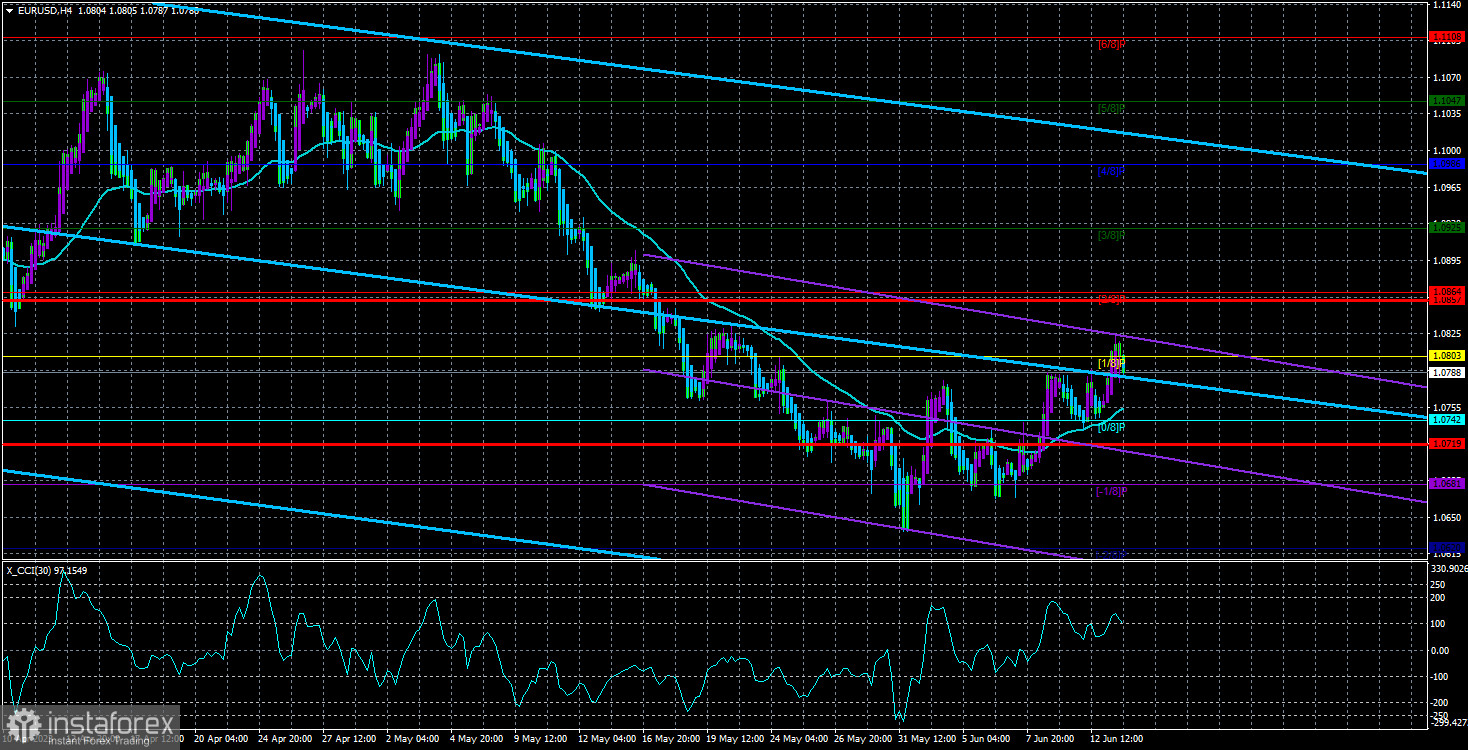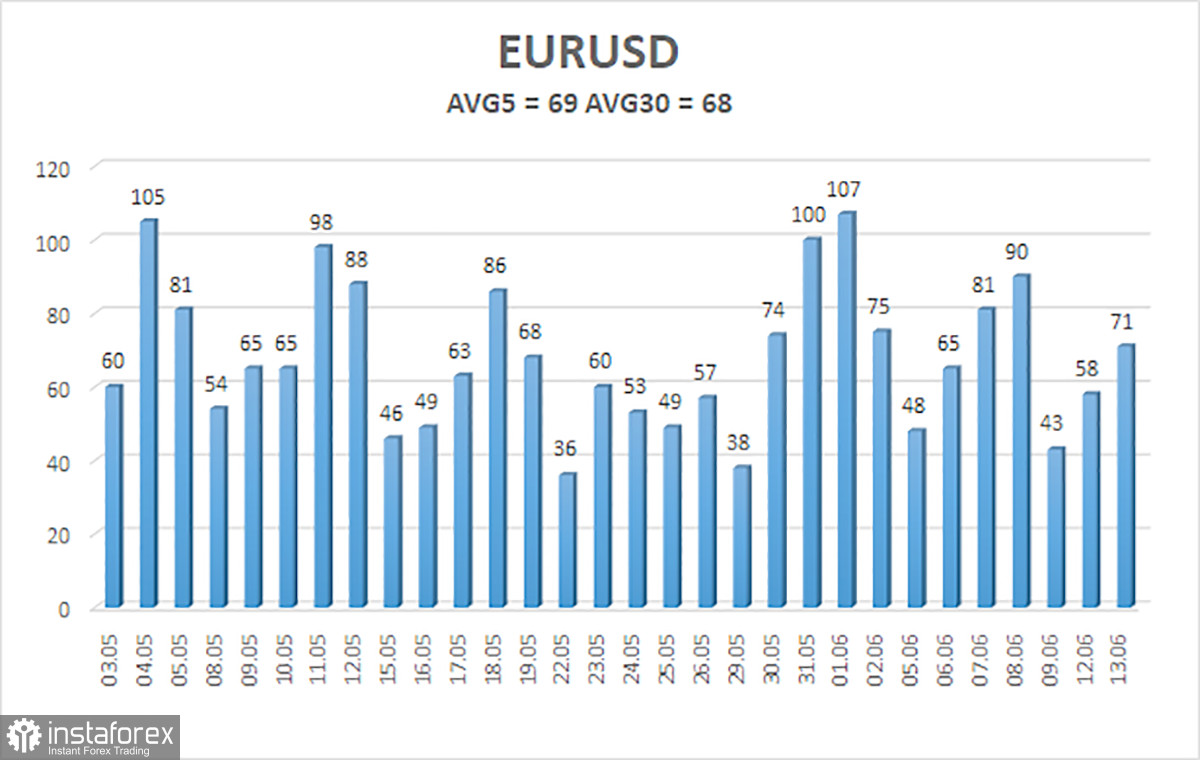
The growth of the European currency began in the morning, before the publication of the most important report of the day on American inflation. Therefore, traders were inclined to buy the euro and sell the dollar from the very beginning. And this is not particularly surprising since the pair is still correcting after a month-long decline. Even when the pair rose for several months, we mentioned that corrections should occur regardless of the overall market sentiment. Therefore, the European currency may now grow based on the technical necessity of a correction.
However, from a medium-term perspective, we expect a new decline in the European currency because there have been no new growth factors in recent weeks. Moreover, if we look at the 24-hour timeframe, it becomes clear that the pair has been rising without significant corrections for almost a year, which means there is a need for a technical correction in the long-term plan. Thus, growth is more likely in the next few weeks, while a decline is expected in the next few months. It should be noted that the Federal Reserve is close to completing its cycle of tightening monetary policy, but the ECB is also close. Therefore, both central banks are in roughly the same position. It turns out that there are no advantages for either the dollar or the euro based on the "interest rate factor." In that case, the technical factor may take precedence.
On the 24-hour timeframe, the pair continues to stay below the Ichimoku cloud, and yesterday it tested the Senkou Span B line (the strongest among the five lines of the indicator) from below. If it is overcome, the upward trend on the daily timeframe may resume. If it bounces off it, the decline may start much earlier than the few weeks mentioned above.
Moving on to pressing issues
The most important report of the previous day was the inflation report in the United States. The consumer price index was expected to drop to 4.1-4.3%, but in reality, it decreased to 4%. Thus, there is only a little left until the target of 2%, and the faster and stronger inflation falls, the higher the probability that the Federal Reserve will complete its cycle of monetary policy tightening, followed by the start of a cycle of easing. Both factors are negative for the US dollar. However, as mentioned, the interest rate balance with the ECB is approximately the same for 2023. Only a few people believe in a prolonged rate hike by the ECB. The market believes two more increases of 0.25% should be expected, which have long been priced in. Therefore, it doesn't matter whether inflation in the United States falls quickly or slowly, whether inflation in the EU falls quickly or slowly; it no longer significantly impacts central bank rates. This is because the Federal Reserve is already close to the maximum rate level, and the ECB cannot raise its rate to the same level as the Federal Reserve.
The market's reaction to inflation was rather weak. In essence, we saw a movement of 30 points in the first two hours. And any movement after a few hours is very difficult to associate with the report, as it may have nothing to do with it. After all, the pair moves not only when certain information is released. Therefore, we pay attention primarily to the movements in the first few hours after an important event. And yesterday, the market showed that inflation reports are no longer considered "important." Therefore, at the moment, "technicals" have a higher priority for the market than "fundamentals," although the results of the Fed meeting will be announced today and tomorrow - the ECB.

The average volatility of the EUR/USD currency pair over the past five trading days as of June 14 is 69 pips and is characterized as "average." Thus, we expect the pair to move between the levels of 1.0719 and 1.0857 on Wednesday. A reversal of the Heiken Ashi indicator back downwards will indicate a possible resumption of the downward movement.
Nearest support levels:
S1 - 1.0742
S2 - 1.0681
S3 - 1.0620
Nearest resistance levels:
R1 - 1.0803
R2 - 1.0864
R3 - 1.0925
Trading recommendations:
The EUR/USD pair stays above the moving average line, but its presence in this area may be short-lived. At the moment, long positions should be considered with targets at 1.0803 and 1.0857 until the Heiken Ashi indicator reverses downwards. Short positions will become relevant only after the price drops below the moving average line, with targets at 1.0719 and 1.0681.
Explanations for the illustrations:
Linear regression channels - help determine the current trend. If both channels point in the same direction, it indicates a strong trend.
Moving average line (settings 20.0, smoothed) - determines the short-term trend and the direction in which trading should be conducted.
Murray levels - target levels for movements and corrections.
Volatility levels (red lines) - probable price channel in which the pair will move in the next 24 hours based on current volatility indicators.
CCI indicator - its entry into the oversold area (below -250) or overbought area (above +250) indicates an approaching trend reversal in the opposite direction.
 English
English 
 Русский
Русский Bahasa Indonesia
Bahasa Indonesia Bahasa Malay
Bahasa Malay ไทย
ไทย Español
Español Deutsch
Deutsch Български
Български Français
Français Tiếng Việt
Tiếng Việt 中文
中文 বাংলা
বাংলা हिन्दी
हिन्दी Čeština
Čeština Українська
Українська Română
Română

